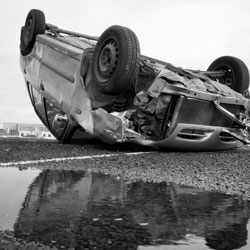 |
| Technology can safeguard other motorists, and help highway authorities to communicate with wayward drivers to avoid accidents |
There has been a spate of accidents worldwide in which cars have been driven either knowingly or unwittingly against the flow of traffic and into oncoming vehicles. Existing and imminent technology from the security sector can prevent such occurrences, alerting responsive drivers to their error and safeguarding other motorists.
I write this shortly after reading that two people have died in the East Midlands of England after a “wrong-way” collision in which an 87-year-old man hit a van head-on when he drove his people-carrier northwards on the southbound lanes of the M1 motorway (known as a freeway, highway or interstate in the US) near the city of Nottingham. At least 350 people die every year in the U.S. as a result of similar incidents.
Video analytics - identifying the exact threat
Anybody working in video analytics will tell you that atypical direction of movement is one of the easiest scenarios on which to generate an alert. The algorithm to recognise this can now reside “at the edge” within a camera and no longer requires central processing at the core. Recent advances in the ability of cameras to cope with rain and fog coupled with the fact that most motorways are well- lit (certainly at exit and entrance ramps) make the slow take-up of scene analysis by highway authorities disappointing. The U.S. National Transportation Safety Board has found that wrong-way crashes on motorways have a fatality rate tthat is up to 27 times that of other high-speed collisions.
Video analytics offers the best means of identifying the exact threat faced by other motorists, but the most robust solution for detecting a wrong-way driver is microwave radar which is of a continuous wave (CW) Doppler type or frequency-modulated continuous wave (FMCW). Radar is a low-maintenance (often solar-powered) solution and unaffected by inclement weather but does not tell first responders exactly what to look for unless combined with cameras.
Cloud communication and even the prospect of mass emergency notification systems with the co-operation of cellular providers are all part of an armoury that should reduce accidents |
Communicating with drivers
Highway authorities worldwide are exploiting advances in variable message signing to communicate with legitimate drivers. The usual instruction is to pull over to the hard shoulder and stop. This is often effective against the hesitant elderly wrong-way driver since, regardless of whether a country drives on the right or the left, a wrong-way driver who thinks they are in the crawler lane will in fact be in the fast lane in terms of oncoming traffic.
Communicating with wrong-way drivers poses specific challenges in that if they are to see a message, it must be mounted on the back of a normal gantry, and many errant drivers are either intoxicated or suffering spatial disorientation which is a common trait with elderly motorists found driving against the flow. A nightmare scenario is that of drivers turning and moving the wrong way in order to correct a previous mistake (such as missing an exit junction) and it is here that video analytics holds the most promise since the manoeuvre is so anomalous it should create an alert.
Help from driver assistance cameras
Even in an era of saturation, CCTV and the extraordinary optical performance of megapixel cameras, it will never be possible to cover every yard of motorways. Having avoided the physical threat to themselves, motorists encountering a wrong-way vehicle on a freeway are usually public-spirited enough to phone emergency services.
This was the case late last year, when a 20-year-old apprentice electrician drove his BMW for nine miles in the wrong direction around the M25 motorway in Greater London. (The M25 is the equivalent of Paris’s ‘Périphérique’ and New York’s I-287 though with speeds as much as a quarter higher.) The journey saw him weaving in and out of oncoming traffic and if you have the stomach to watch it, Kent Police has posted footage on its official YouTube channel.
Motorists who are making an innocent mistake may soon receive help from driver assistance cameras. Currently used to correct errors such as poor lane discipline, intelligent on-board cameras are already being used by Mercedes-Benz to identify no-entry signs. Data from the cameras is also compared with information retrieved from GPS navigation, and wrong-way driving results in an immediate alert.
 |
| The wrong direction of movement is one of the easiest scenarios on which to generate an alert in video analytics |
Warnings via the Cloud
In 2016 Bosch plans to begin supplying manufacturers with software that will place a car’s progress in a database of roads, alert the motorist promptly to wrong-way driving and even stop the vehicle if necessary.
Crucially, the software will also send alerts to the Cloud in order to warn other motorists of the errant driver and activate variable message signing. The limiting factors take-up rates from purchasers and availability of robust Internet connections. The development has caused concern among observers in the U.S., notably Gulf Coast inhabitants, who note that a robust disable feature would be vital since it is common for all lanes on a highway to be available to traffic fleeing a hurricane.
Ashutosh Saxena, a faculty member at Cornell University, has gone way beyond simple algorithms that create alarms on atypical direction to the analysis of complex combinations of driver head movements. The analysis is placed in the context of the road ahead by drawing information from street maps and satellite systems. The research may soon be a reliable source of warnings when a driver is about to make an illegal turn onto a motorway (or any other road) but will of course be available in the first instance only on high-end cars.
Those determined to injure themselves or others will continue to pose a threat on motorways but the length of time they spend driving the wrong way before being apprehended is likely to diminish. Increasingly sophisticated radar, automated video analysis, Cloud communication and even the prospect of mass emergency notification systems with the co-operation of cellular providers are all part of an armoury that should reduce accidents.










































